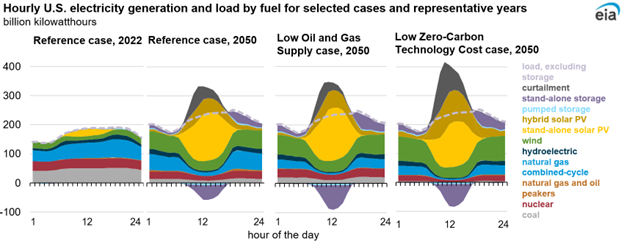Annual Energy Outlook 2023 Heralds New Energy Policy Era
The past two years have brought successive waves of energy and climate policy enacted into law that will fundamentally alter the future of U.S. energy supply, demand, and emissions. However, significant uncertainty exists in understanding what has been enacted and how current and future technologies will be deployed, let alone understanding what additional policy and energy-related investments may be needed to meet the U.S. stated emission goals. Amid this uncertainty, on March 16, 2023, Resources for the Future (RFF) hosted the release of the U.S. Energy Information Administration’s Annual Energy Outlook (AEO) 2023. This much-anticipated report describes EIA’s independent view of energy markets reflected in several core scenarios. Scenarios were conducted using the National Energy Modeling System (NEMS), a complex energy model of U.S. supply and demand created and maintained by EIA.
The core scenarios include a reference case and several alternative scenarios providing insights into a range of potential outcomes resulting from assumptions about future oil prices, oil and natural gas resources, macroeconomic levels, and renewable costs. A significant effort has been made by the agency to reflect the many varied provisions of the recently enacted Inflation Reduction Act (IRA). The previous year saw the enactment of the Bipartisan Infrastructure Law (BIL) and the CHIPS Act that also sought to affect the future course of U.S. energy and emissions.
EIA’s AEO 2023 considers how major shifts in daily electricity generation might play out through 2050 in light of significant unknowns

EIA identified four key findings to assist with building a narrative understanding of its projections. These findings included the following:
- Energy-related CO2 emissions fall across all AEO2023 cases because of increased electrification, higher equipment efficiencies, and more zero-carbon electricity generation.
- Renewable generating capacity grows in all regions of the United States in all AEO2023 cases, supported by growth in installed battery capacity.
- Technological advancements and electrification drive projected decreases in demand-side energy intensity.
- The United States remains a net exporter of petroleum products and of natural gas through 2050 in all AEO2023 cases.
EIA Emphasizes Uncertainty in Projections
There are hundreds of energy-related provisions in the IRA alone, many of which are not well-defined, and the AEO 2023 projections represent only one view of the potential range of impacts of these provisions. To emphasize that point, the EIA has placed renewed emphasis on the range of results across cases. In addition, the agency has put forward some cases that are combinations of standalone cases to further delineate a range of potential outcomes to extend the bounds of uncertainty further. Even with those caveats, the agency says that not all aspects of the IRA have been modeled because so much is still undefined.
OnLocation Knows NEMS and How to Model Energy Policies and Technologies
The key to better understanding the opportunities and challenges of the future is by taking a deep and systematic dive into one or more aspects of the energy economy. The release of the AEO each year provides OnLocation with new opportunities to use the latest AEO core scenarios as well as the updated NEMS model as the basis for exploring alternative energy policies and technologies for both government and private clients. AEO scenarios and model assumptions reflect existing energy and environmental laws, the current slate of technology options, and historical trends in consumer choice and behavior. These scenarios do not predict what will happen but instead reflect what could happen if current laws and trends remain the same in the future. This provides an excellent starting point to create customized versions of the model to explore the impact of new policies and technologies for OnLocation’s clients by changing the underlying assumptions and comparing the model results to the AEO “business as usual” scenarios. Our consultants are uniquely qualified to perform a wide range of energy and environmental scenarios including:
- Additional BIL provisions related to CO2 capture, transport and storage;
- Additional IRA provisions not covered by the AEO 2023;
- CO2 deep decarbonization scenarios meeting the Administration’s net zero climate goals;
- Expanded tax incentives to support clean technologies such as electric vehicles, building energy efficiency, renewables, or CO2 capture technologies;
- Extended efficiency standards for light-, medium- and heavy-duty vehicles;
- Changes to domestic oil and gas production, imports/exports; and
- Many more.
Further discussion of how OnLocation understands the uncertainties and challenges of today can be found in our article Decarbonization: Resolving Uncertainty with Modeling and Engineering.
OnLocation consultants work with clients to determine the best approach to meet their needs including designing and implementing model scenarios, customizing the NEMS model with new capabilities, and presenting scenario results and insights. We also perform research and supplemental analyses to support these modeling services and assist our clients in solving their energy questions. To learn more, To learn more, download our free Services Guide.
OnLocation has a long history with EIA and the NEMS model. Since NEMS was created, we have worked closely with EIA to provide NEMS modeling support, ranging from model design and development activities to data updates and operational services. Our modeling experts have made major updates and improvements to many of the modules of NEMS, especially to the Electricity Market Module (EMM) and Liquid Fuels Market Module (LFMM). OnLocation also built new submodules for use in NEMS including the CO2 Transport, Utilization, and Storage (CTUS) Module that builds out an optimal pipeline network for transporting and storing captured CO2 and the Renewable and Electricity Storage (REStore) Module that performs an hourly dispatch of electricity storage and variable renewable generation. See our blog to learn more about the REStore model’s design and implementation using the AIMMS modeling platform.
For more information about the NEMS model and integrated energy modeling, visit our website and read our NEMS blogs for answers to common questions about the model, including its capabilities and limitations, the cost of a model run, and the time it takes to perform model scenarios.

